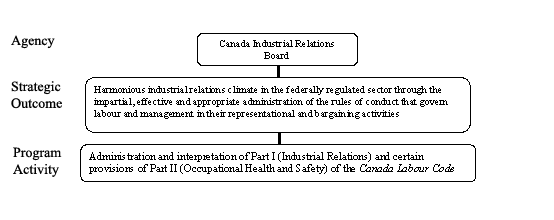Common menu bar links
Breadcrumb Trail
ARCHIVED - RPP 2007-2008
Canada Industrial Relations Board
 This page has been archived.
This page has been archived.
Archived Content
Information identified as archived on the Web is for reference, research or recordkeeping purposes. It has not been altered or updated after the date of archiving. Web pages that are archived on the Web are not subject to the Government of Canada Web Standards. As per the Communications Policy of the Government of Canada, you can request alternate formats on the "Contact Us" page.
SECTION I – OVERVIEW
1.1 Message from the Chairperson
 I am pleased to present to Parliament
and to Canadians the 2007-08 Report on Plans and Priorities for the Canada Industrial Relations Board (CIRB). This will
be the last report under my governorship as my term ends as of December 2007. Since my appointment as the Chairperson
of the CIRB in January 2004, it has been my commitment to ensure that the Board achieves its mandate of contributing to
and promoting a harmonious industrial relations climate in the federally regulated sector as effectively and
efficiently as possible. Specifically, my immediate goals were to ensure that our decisions were timely and consistent,
as well as sound in both law and labour relations terms. Also, I wanted the CIRB to improve its relationship with the
broad federally regulated industrial relations community that we serve.
I am pleased to present to Parliament
and to Canadians the 2007-08 Report on Plans and Priorities for the Canada Industrial Relations Board (CIRB). This will
be the last report under my governorship as my term ends as of December 2007. Since my appointment as the Chairperson
of the CIRB in January 2004, it has been my commitment to ensure that the Board achieves its mandate of contributing to
and promoting a harmonious industrial relations climate in the federally regulated sector as effectively and
efficiently as possible. Specifically, my immediate goals were to ensure that our decisions were timely and consistent,
as well as sound in both law and labour relations terms. Also, I wanted the CIRB to improve its relationship with the
broad federally regulated industrial relations community that we serve.
I believe that I have met my commitments and that the Board has more than met its mandate. We have reviewed and modified the processing of a number of types of cases, which comprise a significant proportion of our workload, and have restructured the operations of our Case Management Secretariat to be more responsive to the needs of the adjudicative team. The effects of these measures have started to pay off, and will leave the Board in a good position to meet its operational challenges in the upcoming years.
With respect to decisions, it should be noted that only two applications (of a total of 146) for a judicial review of Board decisions before the Federal Court of Appeal have resulted in the decision being overturned in the last five years. This is a clear indication that our decisions have been sound from a legal perspective.
The Canadian industrial relations environment is currently in a period of relative stability, as the economy continues to show strength, and unemployment levels are at a thirty-year low. Strikes and lockouts were at their lowest level in over a decade and a half in 2006, and the average length of collective agreements has been rising. This relative stability is also reflected in the Board’s own caseload, as the number of applications/complaints, particularly unfair labour practice complaints, has fallen considerably in 2006-07.
While the Board’s main operational priorities for 2007-08 will be to monitor and make any appropriate adjustments to the measures recently put into place, it will also continue to look at various other means to improve the Board’s efficiency in consultation with its Client Consultation Committee. The primary focus of these consultations will be the discussion of added measures that could be adopted to further expedite the disposition of matters and reduce the number of pending cases — a priority that has been identified by the client community in past consultations.
The challenge facing the Board in the short term will be to maintain its rate of case adjudication. A reduced adjudicative capacity, a situation that also affected the Board in 2004-05, resulted in the Board processing fewer matters in 2006-07 than in previous years. This situation is expected to become critical in the next year, as the term of three of the remaining four Vice-Chairs will expire, as well as my own. Any delay in the appointment of new Board Members will seriously affect the CIRB’s ability to fulfil its mandate.
I would like to take the occasion to recognize the contribution and commitment of my fellow Board Members and staff in making the CIRB a more efficient and effective organization. The Board has been fortunate to be assisted by highly qualified, experienced and hard working staff at all levels within the organization. I have also been most fortunate to be able to work with Vice-Chairs and Board Members, both full and part time, who were incredibly dedicated to achieving the Board’s goals as well as accepting of my leadership. The culture of dispute resolution that has been developed should serve the Board well in meeting its upcoming challenges.
Warren R. EdmondsonChairperson
1.2 Management Representation Statement
I submit for tabling in Parliament, the 2007-2008 Report on Plans and Priorities (RPP) for the Canada Industrial Relations Board.
This document has been prepared based on the reporting principles contained in the Guide for the Preparation of Part III of the 2007-2008 Estimates: Reports on Plans and Priorities and Departmental Performance Reports:
- It adheres to the specific reporting requirements outlined in the TBS guidance;
- It is based on the department’s strategic outcome(s) and Program Activity Architecture that were approved by the Treasury Board;
- It presents consistent, comprehensive, balanced and reliable information;
- It provides a basis of accountability for the results achieved with the resources and authorities entrusted to it; and
- It reports finances based on approved planned spending numbers from the Treasury Board Secretariat.
Chairperson
1.3 Program Activity Architecture

1.4 Summary Information
| Raison d’être – The mandate of the Canada Industrial Relations Board is to contribute to and promote a harmonious industrial relations climate in the federally regulated sector through the impartial, effective and appropriate administration of the rules of conduct that govern labour and management in their representational and bargaining activities. In achieving this strategic outcome, the Board provides effective industrial relations solutions for the Canadian labour relations community in a fair and timely manner. |
Financial Resources
|
2007-2008
|
2008-2009
|
2009-2010
|
|
($ thousands)
|
($ thousands)
|
($ thousands)
|
|
12,437
|
12,437
|
12,437
|
Human Resources
|
2007-2008
|
2008-2009
|
2009-2010
|
|
FTEs
|
FTEs
|
FTEs
|
|
110
|
110
|
110
|
1.5 Context and Background
The Canada Industrial Relations Board (CIRB) is an independent, representational, quasi-judicial tribunal responsible for the administration and application of the Canada Labour Code (the Code), Part I, Industrial Relations, and certain provisions of Part II, Occupational Health and Safety. It was established in January 1999, to replace the previous Canada Labour Relations Board (CLRB), through amendments to Part I of the Code.
The adjudicative team of the Board is currently composed of the Chairperson, four full-time and three part-time Vice-Chairpersons, and four full-time and four part-time Members — all of which are Governor in Council (GIC) appointments. It may be of interest to note that the Code requires that the Chairperson and Vice-Chairpersons must have experience and expertise in industrial relations, and that Members are to be appointed by the Minister of Labour, after consultation with the organizations representative of employees or employers.
The CIRB has jurisdiction in all provinces and territories with respect to federal works, undertakings or businesses in the following sectors:
- Broadcasting
- Chartered banks
- Postal services
- Airports and air transportation
- Shipping and navigation
- Inter-provincial or international transportation by road, railway, ferry or pipeline
- Telecommunications
- Grain handling and uranium mining and processing
- Most public and private sector activities in the Yukon, Nunavut and the Northwest Territories
- Band Councils and some undertakings of the First Nations on reserves;
- Certain Crown corporations (including, among others, Atomic Energy of Canada Limited)
This jurisdiction covers some 1,000,000 employees and their employers, and includes enterprises that have an enormous economic, social, and cultural impact on Canadians from coast to coast. The variety of activities conducted by the federally regulated sector, as well as its geographical spread and national significance, contribute to the uniqueness of the federal jurisdiction and the role of the CIRB, and pose particular challenges for the Board’s work.
The Board has established a series of strategic objectives in support of its mandate, which include to:
- conduct all its processes in accordance with the standards of the Code;
- seek solutions to labour relations problems by determining the cause and nature of conflict and by applying the appropriate dispute resolution mechanism, including fact finding, mediation and adjudication;
- conduct its activities in a timely, fair and consistent manner;
- consult its clients on its performance and on the development of policies and practices;
- promote an understanding of its role, processes and jurisprudence through continuous client contact and a variety of information dissemination methods (Web-based and conventional publishing, Board presentations at various forums, 1-800 information request line, etc.);
- conduct its business and manage its resources in a manner that is fiscally sound, in accordance with the Financial Administration Act and the policies and directives of the central agencies of government; and
- ensure continuous interaction with those utilizing Board services through meaningful communication and complaint processes.
Program Priorities
| Activity/Initiative | Type |
| Accelerated reduction of the number of backlog cases (Chart 1) | Ongoing |
| Reduction of average case disposition time | Ongoing |
| Monitoring and fine-tuning of new certification application process and disposition | Ongoing |
| Monitoring and fine-tuning of new duty of fair representation complaint process and disposition | Ongoing |
| Review of reconsideration application process and disposition | New |
| Client consultations | Ongoing |
